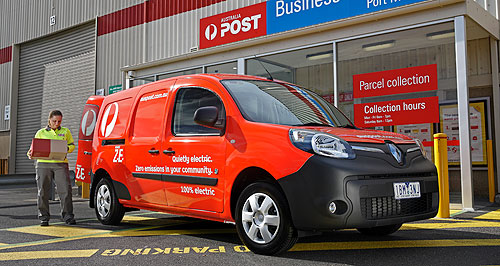Make / Model Search
News - Renault - KangooRenault provides four electric Postie vansCharged: With a range of between 80 and 125km, the Kangoo ZE won’t be making any long-distance parcel deliveries. Australia Post the first step in Renault’s plan to trial EV Kangoo ZE among fleetsGallery Click to see larger images 26 May 2014 RENAULT and its major local fleet partner Australia Post have today announced the beginning of a 12-month electric vehicle trial that will see four Kangoo ZE Maxi EVs enter service delivering parcels in Melbourne from June and Sydney by year’s end. The pilot project marks the introduction of the ZE to the local market, with Renault hoping to discover more about specific EV driving habits among Australians, as well as how to best support larger-scale fleets of EV commercials in the mid-term future. Since late 2011, Renault has sold more than 14,000 Kangoo ZEs worldwide. About 4000 of these serve as short-distance vans in the French postal services, travelling on average around 70km per day. The battery-powered Kangoo has a real-world driving range of between 80 and 125km and an official NEDC range of 170km. Power comes from a 44kW/226Nm AC electric motor matched to a 22kWh lithium-ion battery that weighs 260kg. A 3kW plug will charge the cells in 6-9 hours. The charging station at Australia Post’s Port Melbourne Business Hub is funded by the Victorian department of transport, planning and local infrastructure. The French company already provides larger, diesel-engined Trafic and Master vans to Australia Post after beating incumbent Mercedes-Benz to win the lucrative five-year fleet contract in 2013. Renault Australia managing director Justin Hocevar told GoAuto in an exclusive interview last week that the company was “excited” to broaden its existing relationship with Australia Post through such a trial. He also said the company was keen to continue its push with electric vehicles in Australia after its first attempt, with the Fluence ZE, was abandoned with the collapse of infrastructure partner Better Place. “We’ve always been excited by the opportunity of EV and we’ve always looked for a way to leverage that global leadership position and all that investment (overseas) into products here in the Australian market,” he said. “Obviously our first attempt with an infrastructure partner – due to their collapse – did not come to fruition, but it didn't mean that we wanted to throw the baby out with the bath water. We’ve always wanted to come back.” Mr Hocevar said Renault Australia would in time also look to further promote its EV range through pilot projects with several other big fleets beyond the postal service, notably those with internal green energy targets. However, he offered no firm timeline on any rollout. “Despite the fact there are no (government) incentives which we think is disappointing for a country like Australia, there are pockets of interest that are coming out more prominently now,” he said. “The cost of EV operation is still higher because of the price of entry, but because there might be other interests within their business, because they wish to leverage a sustainability message, because they might have environmental objectives … they’re coming to us and saying, ‘Okay, we’re willing to wear some difference or fund some difference for our fleet operation.’” Australia Post head of environmental sustainability Andrew Sellick said operating the four EVs in the two major capital cities would be an “exciting step forward that tangibly demonstrates our commitment to the environment”, and could pave the way for a larger ZE fleet contract. “The vehicles will be powered by accredited GreenPower from renewable energy sources to ensure we are maximising the potential to reduce our environmental impact,” he said. “While at this stage we are working with Renault to prove this concept, if the vans perform well across the range of metrics we’ll be measuring them on, the future potential is very exciting. We hope this initiative will ultimately help drive the commercialisation and acceptance of electric vehicles in this country.” While Renault and alliance partner Nissan are established as world leaders in large-volume EVs, the French company’s deployment of these vehicles in Australia has been repeatedly delayed. Renault Australia repeatedly said it was exploring the business case for both the Kangoo ZE in 2011 and the Zoe light car in 2012, but a lack of demand for electric vehicles among the Australian general public, amplified by a lack of government assistance, meant they have failed to stack up. Because the vehicles supplied for the Australia Post trial are not being sold to the fleet partner, Renault Australia has not released pricing for the Kangoo EV. However, in European markets where the vehicle is on sale alongside a diesel-engined version, the battery-powered van carries about a 20 per cent loading – which means it could carry up to a $4000-$5000 premium in Australia.  Read more25th of March 2014  Renault charges up for Kangoo EV trialBattery-pack delivery vans to take to Australia’s streets in the name of research17th of July 2013  Zoe still not off Renault’s agendaRenault says government incentives needed to make Zoe EV competitive |
Click to shareRenault articlesResearch Renault Kangoo pricing
Motor industry news |




















Facebook Twitter Instagram